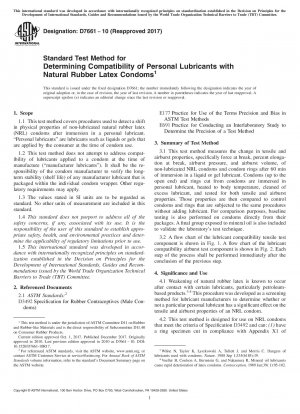ASTM D7661-10(2017)
Standard Test Method for Determining Compatibility of Personal Lubricants with Natural Rubber Latex Condoms
- Standard No.
- ASTM D7661-10(2017)
- Release Date
- 2010
- Published By
- American Society for Testing and Materials (ASTM)
- Status
- Replace By
- ASTM D7661-18
- Latest
- ASTM D7661-23
- Scope
-
4.1 Weakening of natural rubber latex is known to occur after contact with certain lubricants, particularly petroleum-based products.3,4 This procedure was developed as a screening method for lubricant manufacturers to determine whether or not a particular personal lubricant has a significant effect on the tensile and airburst properties of an NRL condom.
4.2 This test method is designed for use on NRL condoms that meet the criteria of Specification D3492 and can: (1) have a ring specimen cut in compliance with Appendix X1 of Specification D3492 and (2) be tested for burst properties in compliance with Annex A2 of Specification D3492.
4.3 This test method is not to be used to determine the safety of either the test lubricant or NRL condom. This test method is to be used only to determine if the tensile or airburst properties of the NRL condom have been significantly affected by the test lubricant.
1.1 This test method covers procedures used to detect a shift in physical properties of non-lubricated natural rubber latex (NRL) condoms after immersion in a personal lubricant. “Personal lubricants” are lubricants such as liquids or gels that are applied by the consumer at the time of condom use.
1.2 This test method does not attempt to address compatibility of lubricants applied to a condom at the time of manufacture (“manufacturer lubricants”). It shall be the responsibility of the condom manufacturer to verify the long-term stability (shelf life) of any manufacturer lubricant that is packaged within the individual condom wrapper. Other regulatory requirements may apply.
1.3 The values stated in SI units are to be regarded as standard. No other units of measurement are included in this standard.
1.4 This standard does not purport to address all of the safety concerns, if any, associated with its use. It is the responsibility of the user of this standard to establish appropriate safety, health, and environmental practices and determine the applicability of regulatory limitations prior to use.
1.5 This international standard was developed in accordance with internationally recognized principles on standardization established in the Decision on Principles for the Development of International Standards, Guides and Recommendations issued by the World Trade Organization Technical Barriers to Trade (TBT) Committee.
ASTM D7661-10(2017) Referenced Document
- ASTM D3492 Standard Specification for Rubber Contraceptives (Male Condoms)
- ASTM E177 Standard Practice for Use of the Terms Precision and Bias in ASTM Test Methods
- ASTM E691 Standard Practice for Conducting an Interlaboratory Study to Determine the Precision of a Test Method
ASTM D7661-10(2017) history
- 2023 ASTM D7661-23 Standard Test Method for Determining Compatibility of Personal Lubricants with Natural Rubber Latex Condoms
- 2018 ASTM D7661-18 Standard Test Method for Determining Compatibility of Personal Lubricants with Natural Rubber Latex Condoms
- 2010 ASTM D7661-10(2017) Standard Test Method for Determining Compatibility of Personal Lubricants with Natural Rubber Latex Condoms
- 2010 ASTM D7661-10 Standard Test Method for Determining Compatibility of Personal Lubricants with Natural Rubber Latex Condoms
